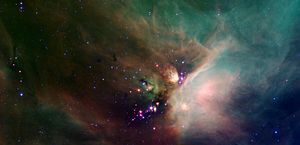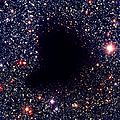Molecular cloud facts for kids

A molecular cloud is a special kind of cloud in space. It's a huge area of gas and dust, so dense and big that tiny particles called molecules can form inside it. The most common molecule found here is hydrogen (H2).
Astronomers find it tricky to spot hydrogen molecules directly. So, they use special infrared and radio telescopes to look for another molecule called CO (carbon monoxide). When they find CO, it usually means there's lots of hydrogen nearby too! These clouds are super important because new stars are born inside them.
Contents
What are Molecular Clouds?
Molecular clouds are the largest objects in our galaxy! They can be hundreds of light-years across. They are much colder and denser than other clouds in space. This cold, dense environment is perfect for atoms to join together and form molecules.
Most of the gas in these clouds is hydrogen. But they also contain other elements like helium and tiny amounts of heavier elements. These heavier elements can form molecules like carbon monoxide (CO) and water (H2O).
Where Do Stars Come From?
Molecular clouds are often called "stellar nurseries." This is because new stars are born inside them! Gravity pulls the gas and dust in these clouds closer and closer together. As more material gathers, it gets hotter and denser.
Eventually, a part of the cloud becomes so hot and dense that nuclear fusion begins. This is the process that powers stars. When fusion starts, a new star is born! Many stars, and even whole star systems, can form from one large molecular cloud.
How Do Astronomers Study Them?
It's hard to see hydrogen molecules (H2) directly because they don't give off much light that our telescopes can easily detect. That's why astronomers look for carbon monoxide (CO) instead. CO molecules glow brightly at certain radio wavelengths.
By mapping where CO is found, scientists can figure out where the hydrogen is. This helps them understand the size, shape, and movement of these amazing cosmic clouds. Studying molecular clouds helps us learn how stars and planets form in our universe.
Images for kids
-
Within a few million years the light from bright stars will have boiled away this molecular cloud of gas and dust. The cloud has broken off from the Carina Nebula. Newly formed stars are visible nearby, their images reddened by blue light being preferentially scattered by the pervasive dust. This image spans about two light-years and was taken by the Hubble Space Telescope in 1999.
-
Young stars in and around molecular cloud Cepheus B. Radiation from one bright, massive star is destroying the cloud (from top to bottom in this image) while simultaneously triggering the formation of new stars.
-
The Milky Way as seen by Gaia, with prominent molecular cloud complex labeled in white, as well as prominent star clouds labeled in black.
See also
 In Spanish: Nube molecular para niños
In Spanish: Nube molecular para niños








